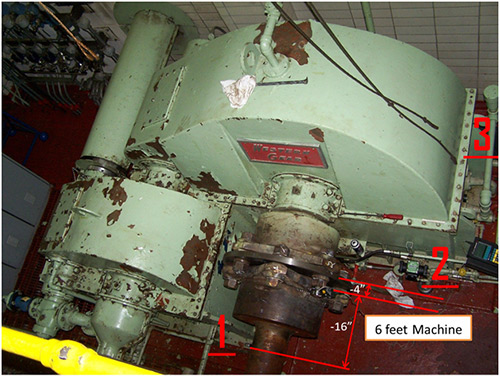Vibration analysis is the best all-around technology for diagnosing and predicting problems in rotating machinery. Over the years I have seen time and time again where adopters of this technology have saved themselves and their companies countless man-hours and thousands of dollars by getting to the root cause of a problem early on. By analyzing the data, they are able to schedule their valuable time on the right problem on the right machine long before the problem escalates into a major outage or emergency. But too many companies have not adopted vibration analysis. While it is true that one could spend many years learning the skills of the multiple levels of the vibration analysis disciplines, it is also true that even a basic understanding of the relationship between the time waveform and the spectrum can yield huge benefits and savings to a new user.
For example, the root cause of most roller bearing/seal failures is either shaft misalignment or rotor imbalance, which can take months to develop. It is also the most common problem analyzed within most facilities in the first two years of vibration analysis implementation. The good news is that misalignment and rotor imbalance are the easiest problems to diagnose by observing a high amplitude 1× running speed frequency in the spectrum. After that, a phase analysis with your analyzer can easily differentiate between misalignment or an imbalance problem and quickly completed without shutting down the machine.
We all know that Rome wasn’t built in a day but we all must start somewhere and just a few days in an analysis class could yield major benefits to new companies.
Thanks to Jay Gensheimer with Solute LLC for this valuable post.
by Ana Maria Delgado, CRL
Often, seal failures are not the cause of an incorrect installation or the wrong seal type for the product being pumped, but a symptom of misalignment. If a seal starts dripping or misting product within days after installation, or suffers a “catastrophic” failure within weeks of being placed in service, the first suspect should not be the seal vendor or the technician installing the seal; misalignment should be considered as a good candidate for the cause of failure. Visualize a typical pump-motor system of bearings, shafts, seals, and coupling. The weakest link in the chain is usually the mechanical seal. In the last ten years, seal technology has progressed substantially in both material composition and design (most notably cartridge seals), in compensating for shaft vibration.
However, significant misalignment can still overwhelm the ability of a seal to keep both seal faces pressed firmly together or to withstand seal face cracking.
So remember, the next seal failure you encounter, quickly check misalignment with a good laser alignment system to see if the weakest link has failed due to misalignment.
by Ana Maria Delgado, CRL

There are several ways of looking at alignment tolerances, including standard versus vector tolerances, as well as sliding velocity tolerances. The most used are standard tolerances, but which are applied differently for short flex versus spacer couplings. The best laser shaft alignment systems will allow you not only to select tolerance types but also coupling types. For standard tolerances, keep in mind that the vast majority of true flexible couplings (such as gear, grid, elastomer element, or diaphragm type) have two separate flex planes. So do all spacer couplings. The difference between short flex and spool piece, spacer, or jackshaft couplings lies in the distance between these flex planes. Any time the distance between flex planes is greater than the diameter of the working flex plane, you are better off calling it a spacer rather than a short flex, from the perspective of achieving satisfactory alignment.
Keep this in mind when selecting coupling type, as it will greatly increase the alignability of the machines, and ease your job in the field. For a deeper understanding of the subtleties involved in these issues, it is recommended to attend an in-depth training course in laser alignment.
Check out the Easy-Laser XT Series, the only laser alignment platform on the market today with the new ANSI alignment tolerances built-in giving the user the freedom to choose between traditional tolerances, the new ANSI standards, or custom tolerances of the user’s own choosing.
by Ana Maria Delgado, CRL
When performing a multiple belt-sheave alignment, it is imperative that all the belts and belt grooves are inspected individually for wear. If any of the belts are slipping, then all belts must be replaced at the same time. To achieve an accurate alignment between the pulleys one can use a machinist’s straightedge, or place a tightly drawn piece of string, across the faces of the sheaves to see if all four points of contact are made or you can utilize a Laser Pulley Alignment tool. Regardless of which system is used to perform the alignment, it is a good practice to monitor any changes in angularity and/or offset in the sheaves as the hold-down bolts of the machine to be moved are being tightened during the belt tensioning procedure, since this will allow the sheave alignment to be maintained true.
by Ana Maria Delgado, CRL
I have been using the ROTALIGN® ULTRA for about one year now and it has made my job easier and faster. I like the ease of the installation of the tool. No more need to multiple dial indicators and carrying different mounting brackets! Everything in the ROTALIGN ULTRA is snug and compact in its own case. All I have to do is grab it and go! The ROTALIGN ULTRA is by far one of the easiest computer-based tools I have ever used; from installing it on the machine to navigating through the screens. One of my favorite options is the “constant sweep” mode. Once you get your laser set and you’re motor data programmed, just hit “go”! Another nice feature is the “Soft Foot Wizard”. No more fighting with dial indicators on each foot pad. The ROTALIGN ULTRA is so effective, it even tells you how much to shim on each foot pad! This has saved me so much time and hassle.
I have used the ROTALIGN ULTRA for Land O Lakes, Disney Land Theme Parks, Rexam beverage, Guardian Glass, Alza Corporation and many more.
One of my favorite things about the ROTALIGN ULTRA is the ease of giving the customer a report as soon as I’m done with the job. I’ll I have to do is save my report and transfer it to a thumb drive. At that point, I take it to the customer and have him save it to his computer! No more need to go back to the shop, download it to my computer and print!
I have done a lot of research on other brands of laser alignment tools and have had the sales representatives do demonstrations on them but when the representative for ROTALIGN ULTRA came to Capitol Air Systems for his demonstration, I knew this was the one for us. It was one of the best demonstrations hands down and the representative even let us get familiar with the operations of it. The time that the ROTALIGN ULTRA has saved me has well paid for itself. —Lonnie E. Owens, Sr., Sr. Field Service Engineer, Capitol Air Systems.
by Ana Maria Delgado, CRL
Many end users have taken laser alignment equipment and “checked” alignments on equipment that has been running satisfactorily, and very often with vibration data that falls well within alarm thresholds, only to find the alignment out of normal alignment tolerances. In this instance, the vibration data should be the determining factor. If the equipment is running well, leave it alone. It would however be a very good practice to keep this alignment data and use it in the future for the intentional misalignment of this particular machine. It is quite possible that the machine had in fact been deliberately misaligned when cold and stopped to compensate for positional changes that occur due to thermal growth or dynamic load shifts.
by Ana Maria Delgado, CRL
Laser shaft alignment has become ubiquitous these days. And for the most part, alignments are very similar from one machine train to another. The user enters the RPM for tolerance evaluation, enters the dimensions of the driver, measures misalignment, and makes corrections. But what happens when an unusual physical configuration exists, as when the foot of the machine is between the flex planes of the coupling? Or the receiver cannot be mounted outboard of the flex planes of such coupling?
Entering a dimension correctly as a negative value can take care of that problem. This will ensure that the corrections at the feet are precise, and the alignment is done properly.
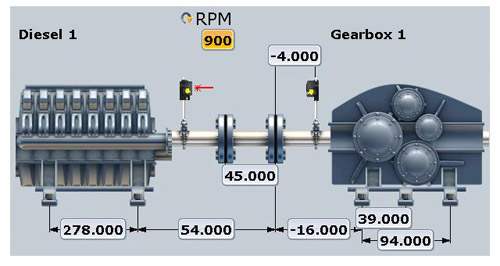
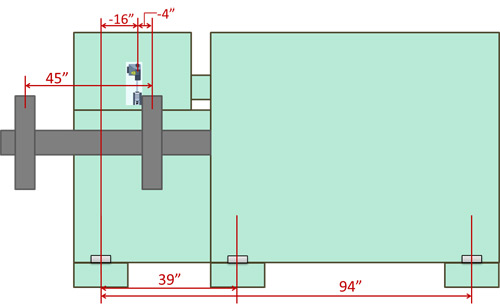
Does your laser alignment system have this crucial capability? Our ROTALIGN® ULTRA laser alignment system does!
by Adam Stredel CRL
Do your analysts use consistent phrases or statements when creating condition monitoring (CM) work orders? It is very important to convey concise and accurate information with each CM work order. Often times misspelled words, inaccurate information, or incomplete maintenance steps are included in work orders. A best practice is to determine the most common findings for a specific CM technology and determine what actions should be taken as a result. For example, if vibration analysis identifies unbalance in a fan, a recommendation should be made to clean the fan prior to attempting to balance it. If a CM technology identifies a failure that requires the machine to be removed, then re-alignment may be necessary before the machine is placed back into service. All of these steps and perhaps additional steps should be conveyed by the CM analyst creating the work order.
Creating consistent and detailed steps for common CM problems will avoid forgetting to convey important information to those doing the work. This will help ensure that best practice maintenance is completed on your equipment, things are not forgotten, misspelled words entered, or other common mistakes made.
by Trent Phillips
When dealing with a gearbox that has 3 feet, there are two possibilities:
a) If the feet are located under the shaft and bearing housings, view the gearbox as a normal 4-foot machine. This will give you inboard and outboard corrections for the feet. The end that has the 2 feet should be corrected evenly, and the 3rd foot should be corrected as per the screen.
b) If the feet are on the sides of the gearbox, or NOT under that shaft or bearing housings, then configure the gearbox as a 6-foot machine. This will give you corrections for the inboard, middle and outboard feet. Correct accordingly at each foot.
by Ana Maria Delgado, CRL
In any alignment situation, one of the most basic principles is rise over run. Think of it as a change in offset over a distance. It is also a way to quantify angles without using degrees. When the laser system measures “angularity”, it expresses it as rise over run, or a change in offset over a distance. This information, along with the dimensions that the user enters is what the system uses to calculate corrections at the feet. That is why it is very important that laser measurements are repeatable and that all dimensions should be accurate to within 1/8 inch. The sensor to coupling dimension is the most critical of these. If the laser measurements are good but the dimensions for the feet are not, any corrections the computer calculates will not work due to the fact that they are “applied” to a different location, not at the actual foot location. If you are making the corrections that the computer says to and your alignment is still off, double check your dimensions.
by Ana Maria Delgado, CRL
In my spare time, I enjoy the hobbies of building bicycles and metalworking. There is something about making things from scratch that satisfies both the kid and engineer in me.
I recently sold a hobby class CNC machine that I purchased about a year ago. It was a capable machine for what it did and the price was MUCH less than the typical Vertical Machine Center (VMC) that you would see in a machine shop. Unfortunately, it didn’t do exactly what I needed. I learned through further education that my machine “should have this capability, must be able to do that, etc.” I also found out that much of the manufacturer’s verbiage such as “step resolution,” “precision,” “computer-controlled,” “complete solution,” and “high quality” was bandied about so much that one would wonder why a machine shop would pay so much more for a quality CNC VMC. Upon talking to other users, I learned more about its shortcomings and what they eventually did: they were now educated and instead invested in machines that actually did what they needed for their applications and delivered on the manufacturer’s promises. Haven’t we all experienced this same situation before when buying cars, TVs, appliances, cell phones, etc.?
Unfortunately, this situation is not isolated to CNC machines and consumer products but extends to all sorts of products – even laser shaft alignment systems. If you make an internet search for laser shaft alignment tools, terms such as “.0001 resolution, laser, high precision, easiest, 3000 points, 60-degree turn, single correction alignments, etc.” are thrown about on websites and it is unfortunate that customers must sort through this and hope they find a laser alignment tool that will truly satisfy the requirements of their reliability program.
How can you make the right decision in buying a laser alignment product? For starters, inform yourself through reliable sources. I would encourage you to talk to other users and get their experiences with the tools. These are people that use shaft alignment for their reliability program. Maybe they have purchased a variety of tools before settling on the right tool that works. Let their experience help save you time in searching for the right product.
I would also encourage you to contact your vendor and ask for a demonstration. Everyone claims to have the best product, but the real proof is that the tool actually works for your reliability program. For example, if you contact us, we have knowledgeable local representatives and an onsite dedicated engineering staff who will gladly visit your facility and answer any questions you may have. We have represented Prüftechnik (the inventors of laser shaft alignment) for 30 years and many of our reps have represented our products for over 25 years. All those years mean that we have the experience, references, and reputation to provide you with the information and resources to make an informed decision.
Buying a laser alignment tool is essential to your reliability program. Its ultimate goal is to reduce the amount of time to do alignments, do them more accurately, and document the results. Doing so will help you accomplish the main goal – improving the reliability of your plant and thereby saving time and money.
by Daus Studenberg CRL
PUMPS & SYSTEMS • August 2012
By James Laxson, Hi-Speed Industrial Services in collaboration with Mike Fitch, LUDECA, Inc.
In May 2010, an electric motor repair service provider in Little Rock, AR, began a condition monitoring program for a new customer. The customer opted for quarterly data collection.
Read the article Pump Train Component Failure, a briefcase history of a component failure in a nominal 1,800 RPM pump train.
by Ana Maria Delgado, CRL
Dial indicators can fluctuate several thousandths; no direct solution to this is available. However, with ROTALIGN® ULTRA, as with the OPTALIGN® SMART and SHAFTALIGN®, a measurement setting known as “Averaging” can be controlled (Figure 1). The averaging feature allows you to control the number of individual data points taken per reading. If there are high vibrations, or positional fluctuations being picked up by the equipment, increasing the averaging can ensure that you obtain a true measurement of the misalignment.
Further data collection analysis can be accomplished after the alignment measurements have been taken by viewing the scatter plot of all individual points/readings using the “Edit Points” feature (Figure 2). With the advanced functionality of ROTALIGN ULTRA, the points with maximum deviation can be found and analyzed (Figure 3). If, for example, one or more points were found to be random, outlying, high vibration peaks, those particular points can be disabled. By disabling the “rogue” points, the Standard Deviation (SD) of the averaged alignment measurement is decreased, thereby giving you an even more accurate representation of the misalignment (Figure 4).
by Ana Maria Delgado, CRL
Problem Overview
A customer approached LUDECA with a machine train alignment consisting of a fan coupled to a fluid drive coupled to a motor. This particular machine train had limited movement/adjustment available (See Figure 1).
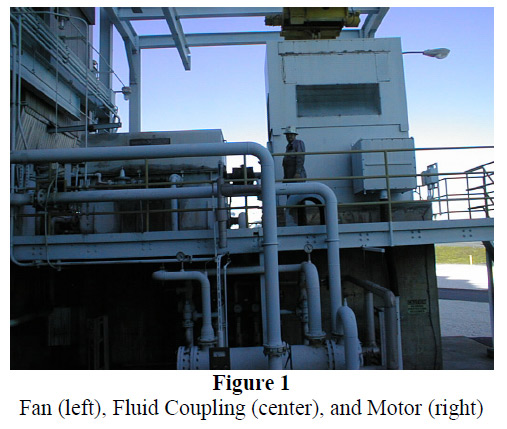
Due to the nature and geometry of the machinery, the fan on the left was stationary, and both the fluid coupling and motor were movable machines. Additionally, the fan could not be rotated. With these limitations and constraints, very careful planning was needed.
Solution
Upon arrival at the site, the LUDECA Field Service Engineer and site personnel began to analyze the situation and figure out the most efficient way to align the machine train. Using the advanced functionality of the Rotalign® ULTRA, uncoupled readings were taken across the fan and fluid coupling, and coupled readings were taken across the fluid coupling and motor. The “As Found” results can be seen in Figure 2.

Per the request of the customer, the alignment was to meet “Short-Flex” Tolerance requirements, even though the coupling was in fact a large gear coupling whose flex planes (points of power transmission) were 13 inches apart. Upon performing the horizontal correction of the motor it became bolt-bound, which prevented further movement in the required direction, New readings were taken and the misalignment is shown below in Figure 3.

Due to the Short-Flex tolerance requirement, the motor needed to move further on both the inboard and outboard feet than was possible. To achieve the Short-Flex tolerances would require very tedious corrections, involving additional movement of both the motor and fluid coupling, or in a more extreme case, re-machining of the bolt holes in the motor feet to allow for more movement. The LUDECA Field Service Engineer suggested that Spacer Tolerances be used. With Spacer Tolerances, the large axial distance between flex planes is taken into account in such a way that the angle at each flex plane is examined individually. This can be done by examining these angles directly in mils per inch, or as the projected offsets of the machine centerlines to each flex plane across the distance between them. With the tolerances set to the spacer-type coupling, the results were viewed once again and it was discovered that the alignment was, in fact, within proper tolerances (See Figure 4). By changing the coupling type from Short-Flex to Spacer, what would have been a tedious and time-consuming task was found to be unnecessary, and was instantly resolved by entering the appropriate coupling type, in this case, spacer coupling. The spacer-type coupling takes into consideration the distance between flex planes, whereas short flex-type ignores it.
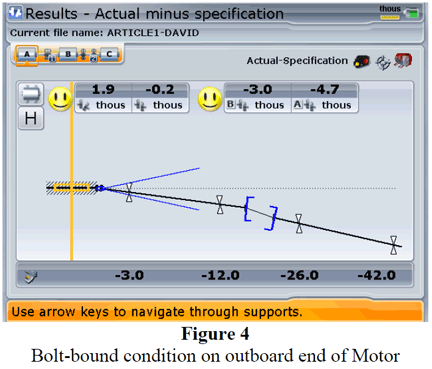
by Ana Maria Delgado, CRL
TURBOMACHINERY INTERNATIONAL • May/June 2012
Thermal growth, as used in the field of machinery alignment means machine frame expansion resulting from heat generation. The generation of heat, of course, is caused by operational processes and forces. Materials subjected to temperature changes from heat generation will expand by precise amounts defined by their material properties.
In turbomachinery, thermal growth results from the temperature differences occurring between the at-rest and running conditions. Generally speaking, the greater the temperature difference, the greater the thermal growth.
The magnitude of the growth can be calculated from three variables:
?T (temperature difference),
C (coefficient of thermal expansion), and
L (the distance between the shaft centerline and the machine supports).
When machinery begins to generate heat, the temperature difference between the at-rest and running conditions will cause thermal expansion of the machine frame, thereby bringing about the movement of the shaft centerlines.
This can produce changes in the alignment affecting the offset and/or angularity between the two machines’ shafts.
If misalignment beyond permissible tolerances occurs in the running condition, it can be observed from both high vibration and excessive power consumption. Operating machinery that is subject to thermal growth without taking into account its effects will result in a loss of efficiency, performance, and reduction in machine or component life.
Relying on the Original Equipment Manufacturers’ data sheets may not be enough as their calculations are performed on a test unit, under specified operating conditions, loads, and field conditions which may be significantly different from operating conditions in the field. These differences can drastically affect the amount of thermal growth observed on a unit in service.
Quantifying thermal growth accurately on turbomachinery to determine the amount of positional change between the machines requires expertise and/or the employment of measurement systems.
Download our article “Thermal Growth: How to Identify, Quantify and Deal with its Effects on Turbomachinery”
by Ana Maria Delgado, CRL
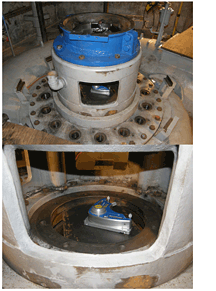 A contractor from Spokane requested a bore centerline alignment of a vertical hydro turbine in northern Idaho. After receiving more detailed information and visiting the site, it was determined that this task would be possible using a combination of the CENTRALIGN® ULTRA STANDARD (a bore laser alignment system) and the LEVALIGN® laser (a laser for flatness and squareness measurement).
A contractor from Spokane requested a bore centerline alignment of a vertical hydro turbine in northern Idaho. After receiving more detailed information and visiting the site, it was determined that this task would be possible using a combination of the CENTRALIGN® ULTRA STANDARD (a bore laser alignment system) and the LEVALIGN® laser (a laser for flatness and squareness measurement).
Download the Vertical Turbine Bearing Alignment case study.
by Ana Maria Delgado, CRL
Maintenance departments periodically schedule maintenance checks on their belt- or chain-driven equipment in order to confirm that a good alignment exists between the pulleys or sprockets, especially if evidence of premature wear on the belts or sprocket teeth is detected.
For this task a Dotline Laser, Sheavemaster or Sheavemaster Greenline laser pulley alignment tool is ideal. It indicates misalignment in all three degrees of freedom (axial offset, horizontal angularity, and twist angle) instantly.
Always mount your laser pulley alignment tool on the smaller pulley and the targets on the larger one, for maximum resolution. Ensure that the mounting surfaces (pulley faces) are free of dirt or rust, and don’t forget to verify the proper tension of the belts (or chains) after the alignment.
Download Belt & Chain Storage Best Practices
by Mario Rostran CRL
When setting up your laser alignment system to align machine shafts, it is very convenient to have the right brackets for the job-ready. The ROTALIGN ULTRA and OPTALIGN SMART feature fully assembled Compact Chain Brackets in the carrying case that are ready to go when you are. These can be used on a vast array of shaft or coupling diameters, from ½” to 20″ requiring no optional accessories, except for using a longer chain for the largest diameters.
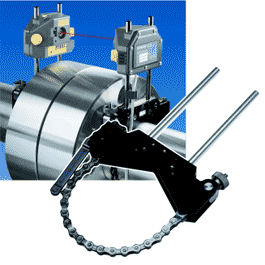
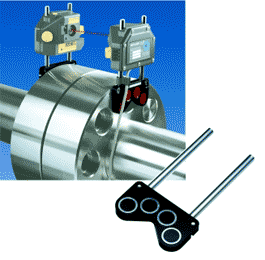
On the rare occasions when the chain brackets won’t fit on the shaft of a particular machine, (such as when there is too little axial clearance between the coupling hub and the bearing housing of the machine, or radial obstructions to rotation interfere), it is perfectly acceptable to mount the fully assembled bracket on the coupling hub, provided that the coupling hub is rigidly attached to the shaft of the machine (i.e., avoid mounting on the floating cover of a gear coupling, say.)
When a suitable radial surface on the rigid coupling hub is not available, or the hub is cone-shaped, it may be better to use the compact Magnetic Bracket System, which mounts to the axial face of the rigid coupling hub, or the Narrow Bracket System which requires only 5/16″ inch axial clearance on the shaft or hub.
For very large couplings, or where radial obstructions to rotation or to line-of-sight exist, consider using Magnetic Coupling Bolt Hole Brackets. These extremely versatile brackets are also useful for mounting to the faces of uncoupled shafts, flywheels, and gearboxes for aligning to bearing bores or stern tubes.
by Mario Rostran CRL
The Associated Builders and Contractors (ABC) announced the winners in its 2012 National Craft Championships competition, held at the association’s EdCon & Expo, April 24-27 in San Antonio.
“ABC is honored to recognize the winners of the National Craft Championships for their high-quality workmanship, technical knowledge and safe work practices,” said 2012 ABC National Chairman Eric Regelin, president of Granix, LLC, Ellicott City, Md. “These craft trainees are the best of the best and show us that there is a bright future ahead for ABC and the U.S. construction industry.”
A field of 127 craft trainees competed for top honors in 12 competitions representing 10 crafts. Competitors first took an intense, two-hour written exam and then competed in daylong hands-on practical performance tests in: residential/commercial carpentry; residential/commercial electrical; commercial/industrial electrical; fire sprinkler; HVAC; insulation; millwright/industrial maintenance mechanic; pipefitting; plumbing; sheet metal; pipe welding;and structural welding.
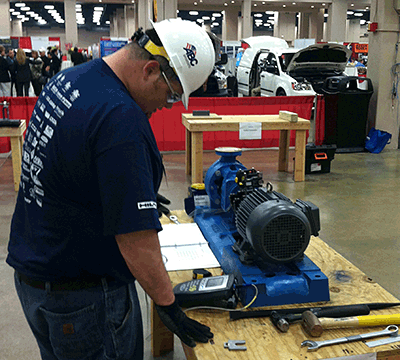 Congratulations to the winners of the Millwright Competition:
Congratulations to the winners of the Millwright Competition:
Gold: Kurt Dickinson
Training Sponsor: ABC Maine Chapter/Cianbro Corporation
Employer: Cianbro Corporation
Silver: Harold B. Harris III Training
Sponsor: ABC Pelican Chapter
Employer: Turner Industries Group, LLC
Bronze: Seth Norton Training
Sponsor: ABC Maine Chapter/Cianbro Corporation
Employer: Cianbro Corporation
LUDECA is proud to have sponspored and supported the event with several SHAFTALIGN laser shaft alignment tools for the Millwright competition.
We can’t thank LUDECA enough for all of your help again this year. It was a great event! —Lisa Nardone, Associated Builders and Contractors
by Ana Maria Delgado, CRL
Background
The practice of dowel pinning machinery was originally conceived within the U.S. Navy, well over a century ago.
This innovation was triggered by the need for a solution to the extreme conditions faced onboard naval surface vessels and submarines by directly-coupled rotating machinery with respect to hull and foundation deflection related to changing temperatures and storms at sea, as well as the forces generated by firing munitions (shells and depth charges.) The original concern that resulted in the use of dowel pins was positional security.
Given the fact that on Navy and commercial vessels excess mass is a major concern, the sound engineering practice of designing a base structure to weigh three to five times the mass of the machinery mounted upon it is impractical, resulting in flimsier, more flexible foundations. This is the principal justification for dowel pinning machines in the Navy, and this practice became almost universally adopted.
After World War II, the vast majority of the industrial maintenance workforce in the United States that dealt with rotating machinery was comprised of men who had served in the Navy, as this was the branch of the armed services with the bulk of such machinery and maintenance need. As a result of deeply ingrained Navy tradition and training, the practice of indiscriminately dowel-pinning all rotating machinery filtered out onto dry land installations, even though in most cases there was no longer any technical justification for this practice.
Download our article “Thoughts On Dowel Pins In Machine Feet” including Positional Security: Technical Considerations, Alternative Solutions, and Positional Repeatability.
by Alan Luedeking CRL CMRP


